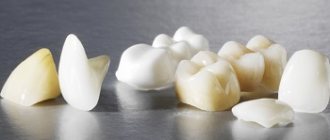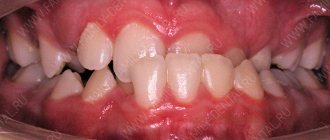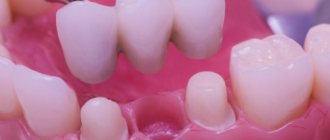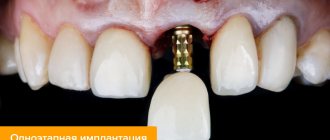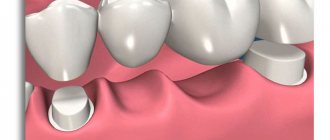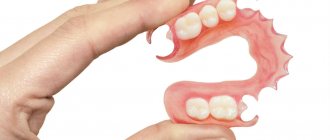Types of crowns for implants
What kind of crowns are placed on implants? Like regular dentures, implant-supported dental crowns come in a variety of types depending on the material. Today, the most popular materials used in the manufacture of crowns on implants are ceramics and metal-ceramics. Their main difference, as the name suggests, is the presence or absence of a metal frame in the design. Recently, it has become popular, for example, to install zirconium crowns on implants - all-zirconium or ceramic restoration structures made on a zirconium frame.
- Ceramic
Dentures made of ceramics are usually recommended to be installed in the area of the front teeth. Such structures are highly biocompatible, which means they do not have any negative effects on the soft tissues of the oral cavity. Plus, they look exactly like natural teeth. Ceramic crowns are more transparent, so in this case an abutment will be made of ceramic or zirconium. - Zirconium
Implant Crowns made from this modern material are most in demand by specialists today. The secret of their popularity is simple: they combine good aesthetic qualities and high strength. - Metal-ceramic
Metal-ceramic is perhaps the most common material used for the manufacture of dentures. Metal-ceramic crowns on implants for chewing teeth are inexpensive and reliable. They usually require a metal abutment.
Metal-ceramic crowns
A metal-ceramic crown installed on an artificial titanium root is not much different from a metal-ceramic crown that is fixed on a natural tooth.
The differences lie in the possible type of fixation of the crown on the implant (read below about the method of transocclusal fixation) and in the more complex process of taking impressions and manufacturing. Metal-ceramic structures are fixed to the implant through metal abutments. After the abutment is installed, the orthopedic dentist takes silicone impressions from the teeth and sends it to the dental laboratory, where crowns for the implants will be made from the impression.
Advantages of metal-ceramic dental structures:
- They can withstand significant chewing loads, therefore they are most often used to restore chewing teeth;
- A properly manufactured prosthesis does not have a pathogenic effect on the oral mucosa;
- Acceptable aesthetic indicators;
- In case of minor damage, the crown must be restored.
What is the best crown to put on an implant?
The answer to this question depends on the area being implanted and your budget. If we are talking about chewing teeth and the patient does not want to overpay, then the doctor will most likely recommend metal ceramics. Zirconium crowns for chewing teeth will undoubtedly be the best option. However, it is also more expensive. If prosthetics takes place in the so-called smile zone, then it is better to place a crown on a ceramic implant. She will look not only beautiful, but also absolutely natural.
Manufacturing of metal-ceramic crowns for implants
The production of a metal-ceramic crown itself proceeds in the same way as with standard prosthetics (except for grinding the teeth, of course):
- The doctor takes impressions of the patient's jaw.
- In a dental laboratory, a casting frame is made, onto which a ceramic mass is subsequently applied.
- After applying layers of ceramics, the crown is fired in a special oven at high temperatures, and then it is glazed.
- Fitting and installation.
Many clinics today use 3D computer technologies, which significantly reduce construction time and improve the quality of prosthetics.
Installing a crown on an implant
Installing a crown on an implant involves putting a specially machined crown on an abutment that connects it to the implant - an artificial root, while crowns for traditional prosthetics are made from casts of ground natural teeth and installed on previously prepared teeth.
How long does it take to place crowns on implants? It all depends on the clinical picture. If immediately after installation the implant is stable and there are no indications for delayed prosthetics, then the implantologist places a crown on the implant immediately. In the area of the chewing teeth, which are not visible when smiling, most likely, a crown will be placed several months after the final implantation.
Installation steps
- After installation, an abutment is placed on the dental implant. Essentially, it replaces the tooth stump that is left after preparing the tooth before installing a conventional crown.
- When the abutment is installed, the doctor takes an impression to subsequently make a permanent crown for the implant.
- The final stage of installing a dental crown on an implant is fixing the prosthesis to the abutment.
Possible complications
Prosthetics using implants practically does not cause any complications. In practice, rejection of an artificial root is recorded in only 2–3% of cases. Some of the most common symptoms of rejection include:
- Bleeding in the surgical area.
- The appearance of pain after installing a crown on an implant.
- Swelling and swelling near the gum pocket.
- Lack of sensitivity in the gum and cheek area.
- Increased body temperature.
Increased discomfort may occur due to inflammation of the gums, rejection of an artificial tooth, or loosening of the abutment. Usually the pain stops after 7-10 days, the swelling has completely subsided. After dentures, it is necessary to follow the doctor’s recommendations in terms of oral hygiene and consumption of certain foods. This will minimize the risk of pathologies. However, if the crown on the implant hurts for a long time, you should consult a doctor to rule out possible complications.
Professional preparation for prosthetics, adherence to the manufacturing technology of the orthopedic structure and correct installation can guarantee the desired result without the risk of possible complications.
Fixation of the crown on the implant: screw and cement
There are two ways in which you can place a crown on an implant - screw and cement. Screw-retained implant crowns involve drilling a hole in a prefabricated crown, which is later sealed. A screw is inserted through it, passes through the crown and is screwed into the abutment. All this happens outside the patient's mouth. When the crown and abutment are securely connected, the latter is secured in a special hole in the implant. Cement fixation of a crown on an implant is similar to the installation of a conventional crown: it is glued to the abutment using special cement - a composite material, while the abutment is already securely fixed in the implant, and the installation procedure takes place directly in the patient’s oral cavity.
All of the above applies to permanent crowns - those that are installed some time after implantation, when the first period of engraftment passes. But in most cases, implantation involves the possibility of instantly loading the implant with a temporary crown.
What are custom abutments and how do they improve esthetics?
Such abutments are manufactured individually for a specific patient, taking into account the anatomical features of the oral cavity and the clinical situation. This provides high aesthetics, excellent functionality, and helps improve the sealing of the crown-abutment-gum interface, preventing unwanted substances from getting under the gum.
An individual abutment is made on a high-precision milling machine, because... any inaccuracies will lead to gaps when the crown “fits” on the abutment and to a decrease in service life.
Why are temporary crowns needed for implants?
Temporary crowns on implants are installed primarily for aesthetic reasons, so that the patient does not walk around with a “hole” in the mouth for the entire healing period. This is especially true for prosthetics in the smile area. In addition, the temporary crown, although not always fully functional, is still involved in speech and chewing. It is distinguished from a permanent crown by the material of production - light plastic, and therefore also by cost and weight. These parameters are important, since spending a lot of money on a temporary crown, which is not needed for a long period of time, is inappropriate, and loading a newly installed implant with a crown of full weight is dangerous. At the same time, externally, temporary crowns are practically indistinguishable from permanent ones, and therefore from natural teeth, their color is matched to the shade of the enamel of the surrounding teeth, all this allows you to hide the prosthetic process from prying eyes.
Pregnancy with dental implants
If you had dental implantation at a young age, then you can safely prepare for pregnancy - the presence of an implant is not a contraindication (provided that the structure has already fully fused with the bone tissue). The only thing you need to pay attention to is the condition of periodontal tissues during pregnancy, since hormonal changes occur during this period and gingivitis and periodontitis often occur, i.e. inflammation of the gum tissue.
During the entire period of pregnancy, it is necessary to see your dentist and pay increased attention to hygiene (you also need to see a therapist or hygienist more often - up to 3-4 times a year). It is also advisable to take vitamin complexes (calcium, vitamin D), unless, of course, there are contraindications. But only under the strict supervision of attending physicians (dentist and gynecologist).
Which is better, a crown or an implant?
When asking a similar question, patients most often mean the installation of dentures based on their own teeth and implantation. What is the difference between a regular crown and an implant? In order to install a conventional bridge, it is necessary to grind down the healthy teeth adjacent to the defect, which will begin to decay over time and the bridge will have to be lengthened. This cannot happen with an implant. Its installation does not affect the “neighbors” in any way, and its service life is not limited. Only the crown will have to be changed. The service life of crowns on implants is about 10 - 12 years, and in many cases reaches 15 years, while with traditional prosthetics, the crown must be changed every 5 - 7 years, grinding the teeth in a new way.
How to properly perform oral hygiene?
- Start morning and evening hygiene by cleaning the interdental space with floss or irrigator, then use a brush and paste. The movements of the brush should be from the artificial gum to the cutting edge of the teeth. Use the brush without pressure/pressure. Finally, use the irrigator again, rinse your mouth with water or mouthwash,
- after a meal (and even a small snack) - the following hygiene complex: it is not necessary to brush your teeth, but it is necessary to thoroughly clean all the gaps in which food could get stuck - especially between the gums and the denture. Use dental floss and/or irrigator, rinse your mouth after
- if any food fragments get between the denture and the gum that you cannot eliminate with the recommended means, you must contact a dental hygienist,
- It is prohibited to use electric toothbrushes, since vibrations and excessive pressure during the cleaning process (especially in the first months after implantation) can lead to poor fixation of the implants,
- Use dental floss with caution and only use one that is marked “super floss” for dentures: the floss can damage the gums around the implant (they are less sensitive than with living teeth, and you will not be so clearly aware of when you need to stop flossing because of due to the absence of pain), bacteria can subsequently enter the tissue around the implant and lead to its rejection,
- Professional teeth cleaning should be carried out with caution and only by those specialists who have appropriate experience in hygiene in the presence of dental implants.
Following simple recommendations will significantly extend the life of implants and prostheses on them. With careful care, problems with implants will not bother you for the rest of your life.
When should you see a doctor?
Contact your healthcare provider if you experience the following symptoms:
- unexpected pain, increased body temperature, chills,
- numbness of the maxillofacial area, which was not there before,
- when pressing on the implants, discomfort or sharp pain occurs,
- redness of the gums, swelling of the mucous membrane, bad breath appeared,
- there is pain in the temporomandibular joint, it is difficult to move the lower jaw, it crunches or does not open/close,
- the teeth do not close together (along the entire length of the dentition or only on one side), there is a feeling of displacement of the prosthesis,
- the prosthesis became mobile, some of the teeth chipped,
- It hurts to chew on one side or use all of your teeth.
The very first and most dangerous period, in which complications most often arise, is left behind. But this doesn't mean you need to relax and forget about your teeth. If you have chosen an adaptive prosthesis, then the next step is to replace it with a permanent structure. In addition, complications can arise after the implants are completely implanted (but this happens extremely rarely). Therefore, just follow your feelings, especially since enough time has already passed and you have an understanding of what is normal and what is a deviation from it. Be attentive to your teeth and your body - be careful and the implants will answer you in kind!
Read more questions and answers about dental implantation in our special section.
What happens if the implant does not take root?
Implant failure is difficult to prevent. The causes of the pathology may be peri-implantitis, smoking, non-compliance with medical recommendations in the early and late postoperative period. If acute rejection occurs, removal of the titanium rod is indicated. Re-implantation is possible only after complete healing of the wound. Rejection can develop several years after the permanent crown is installed. A number of external and internal factors can provoke a pathological process and destabilization of the implant.
How long can you wear implants without crowns?
If we consider a two-stage implantation protocol, then you will have to walk without permanent crowns for six months. To restore the aesthetics and chewing function of the dental system, temporary plastic crowns are fixed 2-3 months after surgery.
Permanent crowns are installed only after successful osseointegration of the implant into the bone tissue. Temporary crowns should be worn not only for aesthetics, but also to prevent atrophy of the bone tissue of the jaw arch and destabilization of the titanium rod.
Metal-free crowns
Such structures do not contain metal elements and consist entirely of ceramic mass or zirconium dioxide. Zirconium crowns have an advantage due to many positive properties:
- A combination of aesthetics and durability.
- There is no metal, so it can be used on the front teeth.
- There is no negative effect on the mucous membrane, the material is safe.
- The color and shape of the crowns are maintained throughout the wearing period.
- Artificial teeth are indistinguishable from natural ones.
- The service life of the product exceeds 20 years with proper care.
The specialists of “Dentistry at Amazing Prices” remind you that in addition to zirconium lined with ceramics, we work with all-zirconium crowns, which, being more affordable, are ideal for prosthetics of chewing teeth.
PROMOTION
Place a Quadrotti denture
30,000 rub.
